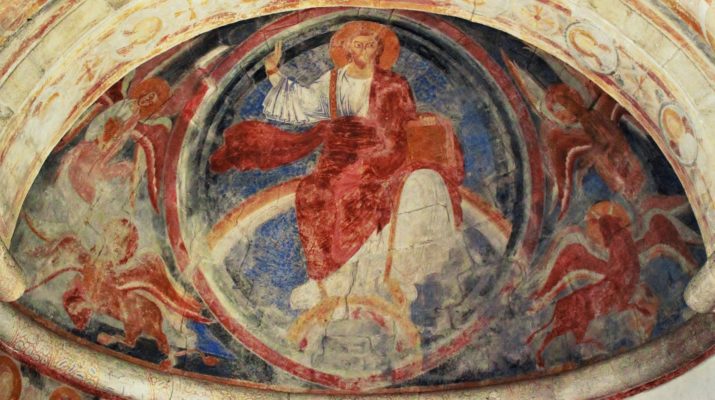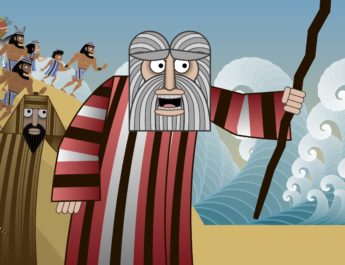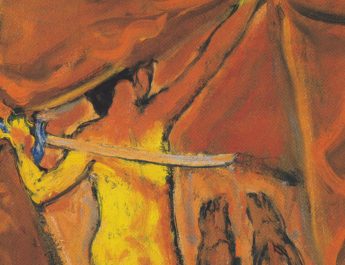Daniel 7:9-10, 13-14
Reign of Christ B
9 As I watched,A
thronesB were set in place,C
and an AncientD OneE took his throne,F
A “watched” = chazah. Aramaic corresponding to Hebrew chazah (to gaze at – to see or behold; perceiving as a mental process or looking at something with pleasure; seeing a vision). This is to see, have a dream.
B “thrones” = korse. 3x in OT. Aramaic corresponding to Hebrew kisse (throne – a seat that is covered or has a canopy; a seat that conveys authority); from the same as kese (full moon); perhaps from kasah (to cover, conceal, overwhelm; to cover as clothes do or to hide a secret). This is throne.
C “set in place” = remah. 12x in OT. Aramaic corresponding to Hebrew ramah (to betray, deceive, beguile, throw). This is to throw, set, assess.
D “Ancient” = attiq. 3x in OT. Aramaic corresponding to Hebrew attiq (old, ancient, removed); from atheq (to move, advance, remove or continue; figuratively, to grow old or to copy or transcribe). This is ancient or venerable.
E “One” = yom. 16x in OT. Literally, “Ancient of Days.” Aramaic corresponding to Hebrew yom (root may mean being hot; day in a literal or figurative sense; birth, age, daylight, continually or other references to time). This is day or a non-specific length of time.
F “took his throne” = yethib. 5x in OT. Aramaic corresponding to Hebrew yashab (to sit and so to remain and so to dwell; sitting for any reason – as a judge, in order to ambush, or just sitting quietly; can mean settling or marrying; continue, endure, or establish). This is to sit, live, or settle.
his clothingG was whiteH as snow,I
and the hairJ of his headK like pureL wool;M
G “clothing” = lebush. 2x in OT. Aramaic corresponding to Hebrew lebush (clothing literally or figuratively; a euphemism for a wife); from labash (to wrap around, which implies clothing oneself or someone else; wrapping around in a literal or figurative way). This is clothing or garment.
H “white” = chivvar. 1x in OT. Aramaic corresponding to Hebrew chavar (to be or become white or pale). This is white
I “snow” = telag. 1x in OT. Aramaic corresponding to Hebrew sheleg (snow or snowy); from shalag (to snow, to be white). This is snow.
J “hair” = sear. 3x in OT. Aramaic corresponding to Hebrew sear (hair, hairy, or rough); perhaps from sa’ar (to storm, scattered by a storm, blow away, rage, storm tossed; this is to toss in a literal or figurative sense). This is hair.
K “head” = resh. 14x in OT. Aramaic corresponding to Hebrew rosh (head, captain, or chief; excellent or the forefront; first in position or in statue or in time). This is head or chief.
L “pure” = neqe. 1x in OT. Aramaic corresponding to Hebrew naqi (blameless, innocent, free from punishment, or clear); from naqah (to be empty, cleanse, acquit; to be clean in a literal or figurative sense). This is clean or pure.
M “wool” = amar. 1x in OT. Perhaps Aramaic corresponding to Hebrew tsemer (wool, shaggy thing). This is wool.
his throne was fieryN flames,O
and its wheelsP were burningQ fire.R
N “fiery” = nur. 17x in OT. Aramaic corresponding to Hebrew ner (properly, to glisten; a lamp, light, burner, candle; light literal or figurative); related to nir (to gleam, till). This is fire or fiery.
O “flames” = shebib. 2x in OT. Aramaic corresponding to Hebrew shabib (flame, spark); from the same as shabab (perhaps from a word for break up; fragment, splinter, blaze, ray). This is flame.
P “wheels” = galgal. 1x in OT. Aramaic corresponding to Hebrew galgal (wheel, wagon, whirl, whirlwind; something that rolls); from galal (to roll, roll away, wallow, commit, remove; rolling in a literal or figurative sense). This is a wheel.
Q “burning” = delaq. 1x in OT. Aramaic corresponding to Hebrew dalaq (to burn or flame in a literal or figurative sense; to chase or hotly pursue). This is to burn.
R “fire” = nur. Same as “fiery” in v9. See note N above.
10 A streamS of fire issuedT
and flowed outU from his presence.V
S “stream” = nehar. 15x in OT. Aramaic corresponding to Hebrew nahar (a stream, river, or flood; particularly used for the Nile or Euphrates; figuratively, prosperity); from nahar (to flow, sparkle, be cheerful). This is a river, also used to refer to the Euphrates.
T “issued” = negad. 1x in OT. Aramaic corresponding to Hebrew nagad (to declare, make conspicuous, stand in front, manifest, predict, explain). This is to stream or flow.
U “flowed out” = nephaq. 11x in OT. Aramaic. This is to flow out, issue, come forth.
V “presence” = qodam. Aramaic corresponding to Hebrew qedem (front, formerly, before, east, eternal, everlasting, antiquity). This is before, toward, from.
A thousand thousands servedW him,
and ten thousandX times ten thousand stood attendingY him.Z
W “served” = shemash. 1x in OT. Aramaic corresponding to Hebrew shemesh (sun or toward the east; root may mean being brilliant; figuratively, a ray or arch). This is to serve or minister, as done during the day.
X “ten thousand” = ribbo. 2x in OT. Aramaic corresponding to Hebrew ribbo (10,000; myriad); from rabab (being many or much, abounding, increasing, multiplying; cast together and so the sense of increasing, generally in number). This is 10,000 or myriad.
Y “stood attending” = qum. Aramaic corresponding to Hebrew qum (to arise, stand, accomplish, establish, abide; rising against, getting up after being sick or asleep, arising from one state to another, becoming powerful, or rising for action; standing in a figurative sense). This is to rise, establish, set up, stand.
Z “him” = qodam. Same as “presence” in v10. See note V above.
The courtAA satBB in judgment,
and the booksCC were opened.DD
AA “court” = din. 5x in OT. Aramaic corresponding to Hebrew din (to judge, defend, dispute, govern, quarrel, plead). This is a judgment, justice, or place where a legal body meets.
BB “sat” = yethib. Same as “took his throne” in v9. See note F above.
CC “books” = sephar. 5x in OT. Aramaic corresponding to Hebrew sepher (writing itself or something that is written like a document, book, letter, evidence, bill, scroll, or register); perhaps from saphar (to tally or record something; to enumerate, recount, number, celebrate, or declare). This is a book or roll or decree.
DD “opened” = pathach. 2x in OT. Aramaic corresponding to Hebrew pathach (to open wide in a literal or figurative sense; to open, draw out, let something go free, break forth, to plow, engrave, or carve). This is to open.
13 As I watched in the nightEE visions,FF
GGI saw one like a human beingHH
EE “night” = lela. 5x in OT. Aramaic corresponding to Hebrew layil (properly, light twisting away; used for night or midnight; figuratively, adversity). This is night.
FF “visions” = chezu. Related to “watched” in v9. 12x in OT. From Aramaic chazah (see note A above). This is a vision or sight.
GG {untranslated} = aru. 5x in OT. Perhaps akin to Aramaic alu (behold). This is lo or behold.
HH “human being” = bar + enash. Literally, “son of humanity.” Bar is 8x in OT. Aramaic corresponding to ben (son literal or figurative; also, grandson, subject, nation); from banah (to build or obtain children). This is son or age. Enash is Aramaic corresponding to Hebrew enosh (human, humankind, mortal); from anash (to be weak, sick, or frail). This is man or humankind.
comingII with the cloudsJJ of heaven.KK
And he cameLL to the Ancient One
and was presentedMM beforeNN him.
II “coming” = athah. 16x in OT. Aramaic corresponding to Hebrew athah (to come or bring; can refer to the past or future arriving). This is to come or become.
JJ “clouds” = anan. 1x in OT. Aramaic corresponding to Hebrew anan (cloud as something that covers the sky); perhaps from anan (cover, cloud over; figuratively, acting in a secret way, practicing magic or soothsaying). This is a cloud.
KK “heaven” = shamayin. Aramaic corresponding to Hebrew shamayim (root may mean being lofty; sky, the air, or heaven; might refer to the part of the sky where the clouds move on the one hand and the part beyond that where the sun, moon, and stars are on the other hand). This is heavens or sky.
LL “came” = meta. 8x in OT. Aramaic perhaps corresponding to Hebrew matsa (to find, catch or acquire; to come forth or appear; figuratively, to meet or be together with). This is to reach, happen, arrive.
MM “presented” = qereb. 9x in OT. Aramaic corresponding to Hebrew qarab (to come near, offer, make ready). This is to approach, offer, present.
NN “before” = qodam. Same as “presence” in v10. See note V above.
14 To him was givenOO dominionPP
and gloryQQ and kingship,RR
OO “given” = yehab. Aramaic corresponding to Hebrew yahab (give, put, bring, take; to give in a literal or figurative sense). This is to give, yield, prolong.
PP “dominion” = sholtan. 14x in OT. From Aramaic shelet (to rule, overpower, have mastery); corresponding to Hebrew shalat (to rule, dominate, govern; it can also mean to bear or permit). This is dominion or empire.
QQ “glory” = yeqar. 7x in OT. Aramaic corresponding to Hebrew yeqar (value, honor, costliness, price); from yaqar (to be precious, costly, rare, valued; properly, to be heavy; figuratively, valuable or inhibit). This is honor or glory.
RR “kingship” = malku. Aramaic corresponding to Hebrew malkut (royalty, kingdom, realm, empire – the power the sovereign has); from the same as melek (king, royal). This is kingdom, royalty, or dominion.
that all peoples,SS nations,TT and languagesUU
should serveVV him.
SS “peoples” = am. 15x in OT. Aramaic corresponding to Hebrew am (people or nation; a tribe, troops or armies, or figuratively to refer to a flock of animals); from amam (to darken, hide, associate; creating shadows by huddling together). This is people.
TT “nations” = ummah. 8x in OT. Aramaic corresponding to Hebrew ummah (tribe or other community); from the same as em (mother as binding a family together or a breeding female animal; mother in a literal or figurative sense). This is nation.
UU “languages” = lishshan. 7x in OT. Aramaic corresponding to Hebrew lashon (tongue, talker, language, or wedge; a tongue of flame or a water cove); from lashan (to lick, slander). This is tongue, speech, or nation.
VV “serve” = pelach. 10x in OT. Aramaic corresponding to Hebrew palach (to slice, bring forth, plow, work, pierce). This is to serve, minister, revere.
His dominion is an everlastingWW dominion
that shall not pass away,XX
and his kingship is one
that shall never be destroyed.YY
WW “everlasting” = alam. Aramaic corresponding to Hebrew olam (a long scope of time whether in the past (antiquity, ancient time) or in the future (eternal, everlasting)). This is old or everlasting. It is a point of time in the distant past or indefinite future.
XX “pass away” = ada. 9x in OT. Aramaic corresponding to Hebrew adah (to advance or continue; to take away or remove; adorning oneself with ornaments). This is to pass, remove, depart.
YY “destroyed” = chabal. 6x in OT. Aramaic corresponding to Hebrew chabal (to break, destroy, ruin). This is to destroy or harm.
Image credit: “Christ in Majesty and the symbols of the Four Evangelists” – at a Romanesque church in Vä, Sweden.




